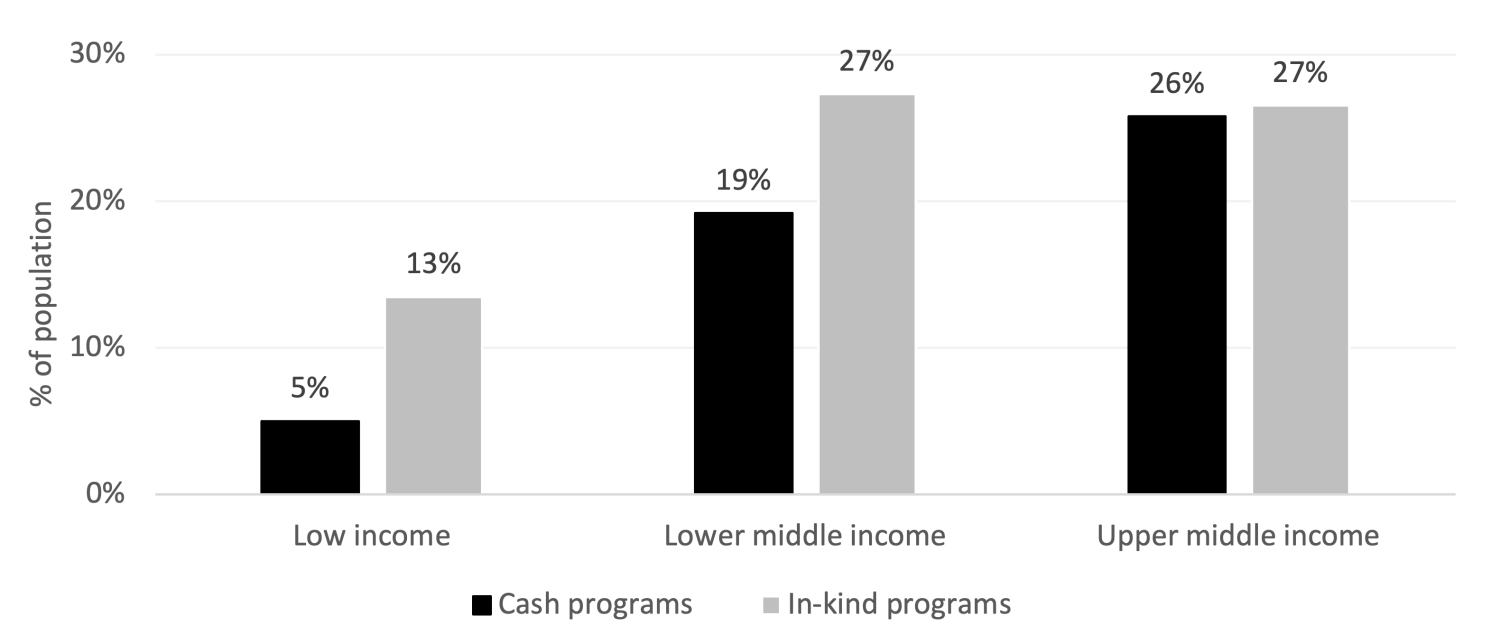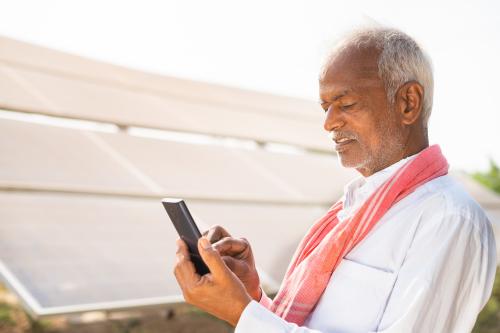Cash transfers are the epicenter of social protection action. Such programs are shielding up to nearly 800 million people from inflation, they covered 1.3 billion individuals during the COVID-19 pandemic, and their use in humanitarian settings more than doubled over the past 5 years.
Yet, in-kind transfers remain widespread. In fact, programs delivering food and other stuff generally reach more people than cash transfers throughout low- and middle-income countries (figure 1). Why is that the case?
Figure 1. Coverage of cash and in-kind programs (percentage population)

Source: ASPIRE database, latest available data over 2010-2019. Cash programs include unconditional and conditional cash transfers, social pensions, and public works. In-kind programs include school meals, food distributions, and other in-kind transfers.
To understand why in-kind food persists at such scale, we need to recognize the different perspectives at play.
Imagine a host inviting six people to discuss whether cash is better than food.
The first to chime in is the beneficiary.
She explains how the fungibility and empowerment that comes with cash gave her agency and confidence. She feels more secure, less stressed, and in better control of her life. Her vote goes for cash transfers.
But she also emphasizes the need to be pragmatic. There are cases—such as particular times in the year or places in her country—when she may pick in-kind food instead. When food prices are skyrocketing, like in Ethiopia and India, people may prefer in-kind assistance. It also depends on how existing programs work: people may opt for cash instead of food when the latter is delivered late, and vice versa.
Then comes the economist.
He would tell you assertively that cash is king, and its coronation is supported by longstanding microeconomic theory based on consumer freedom and choice.
Now, the economist acknowledges that cash and in-kind transfers have a similar effect when in-kind is inframarginal (or when low amount of food is provided), in which case it does not alter consumption patterns.
But the economist also muses about the so-called cash-out puzzle—even when they should be similar in theory, cash and in-kind transfers may exhibit different consumption effects in practice. For example, in the United States inframarginal food vouchers have been found to yield more food intake among beneficiaries than an equivalent amount of cash.
It’s time to hear from the political scientist.
After gently scolding the audience for overlooking the politics of cash (the group nodded), she outlines the multiplicity of goals pursued by in-kind assistance. It is not just about social assistance, she will remind the host: other objectives include supporting farmers via guaranteed procurement and helping countries manage food-price volatility through grain reserves.
The political scientist underscores that food is a sensitive issue. People may expect and pressure governments in assuring affordable food. This may be the case in Egypt, where food subsidies currently absorb 1.4 percent of GDP and reach over 90 percent of the population, and in Iraq, where food subsidies are universal.
She will also note that in-kind assistance requires heavy logistics. As such, there may be a possibility to gain political support from a range of actors involved in supply chains. Such a constituency, however, would be inclined to protect vested interests and resist reform. But we are not doomed, she concludes, and Indonesia shows that successful reforms are possible.
The nutritionist raises his hand.
He will pay attention to health status, the quality of food available locally, and spending patterns of consumers. He will argue that not everything can be monetized and that there are particular goals for which a dose of healthy paternalism is justified—alternatively to or in combination with cash.
For example, he may call for using therapeutic foods to treat child malnutrition; or for vouchers that eliminate temptation goods, such as sugar-sweetened beverages, and nudge people toward healthier diets.
Who’s next? The practitioner!
Armed with the latest evidence, she will show that the impact of cash and in-kind transfers on food security is similar. But, she observes, cash is generally cheaper to administer than in-kind food. Such cost-effectiveness makes her lean for cash.
Her experience in humanitarian settings reminds her of some exceptions, including cases where bulk procurement of large food quantities can reduce costs and offset the higher logistics requirements.
The differences between vouchers and cash, she also notes, are blurring: vouchers can increasingly be used for online purchases, while the use of cash can be restricted to particular stores and areas (like the pandemic e-money payments in South Korea).
The practitioner believes that food security is key, but living in poverty also means plenty of bills to pay while not being able to save and invest. “How can a box of food commodities attend to those diverse needs?” she would ask the audience.
Last but not least comes a mysterious figure: the median voter.
He calmly explains that he embodies society, and his views on cash and in-kind transfers are shaped by deep-seated beliefs on the causes of poverty and attitudes toward redistribution.
While his general motto is “cash is earned, food is deserved,” his specific preference could swing anywhere between generous unconditional cash transfers and modest in-kind assistance compounded by work requirements. South Africa displays a rich set of cash grants while neighboring Botswana favors limited public works and food transfers.
The host is lost. How to reconcile the six perspectives just outlined? Almost by design, the decision may not make everyone happy.
Three possible scenarios emerge.
The first route is to simply not rock the boat and improve at the margin. Policymakers can continue strengthening various cash and in-kind programs already in place and keep introducing new ones when needed. The upside of it is limited political conflict and operational continuity in provisions; the downside is path-dependency and program proliferation. This is probably the closest scenario to the current situation.
The second pathway is to constantly assess and decide what is best, case by case. This involves developing a broad policy framework within which local-level officials can apply a consistent set of tools to select transfer modalities. The pros are evidence-based accountability and adherence to changing local contexts; the cons are hefty data requirements and heavy operational burden placed on frontline implementers.
The third trajectory is to designate a default modality. If we live in a world that is increasingly connected, urbanized, financially inclusive, and where food is accessible, it may be reasonable to consider cash transfers as the default. This means taking cash as the benchmark and shifting the burden of proof to in-kind to demonstrate why it is needed. The pros are pragmatism and standardization; the cons are less diversity and a risk of amplifying a cash ideology.
Whichever direction is pursued, and there might be other options of course, there are a few cross-cutting issues to prioritize.
For instance, we must consider the intended and unintended market effects—some positive and others negative—of either transfer modality. This was highlighted over three decades ago, and yet how to practically anticipate those effects in routine operations remains a challenge. We need flexibility, which means protocols to help switch from one modality to the other when circumstances change. We need to compare costs and benefits across modalities more systematically and consistently. And we need delivery systems that underpin both modalities, not just one or the other.
Most important, we need frequent meetings with these six people to keep an open mind and constantly learn from different worldviews.







Commentary
Why does in-kind assistance persist when evidence favors cash transfers?
Meet the six people shaping the debate
June 30, 2023